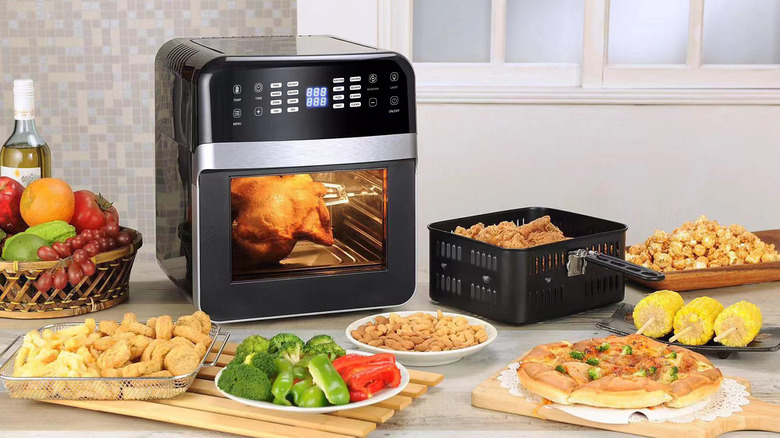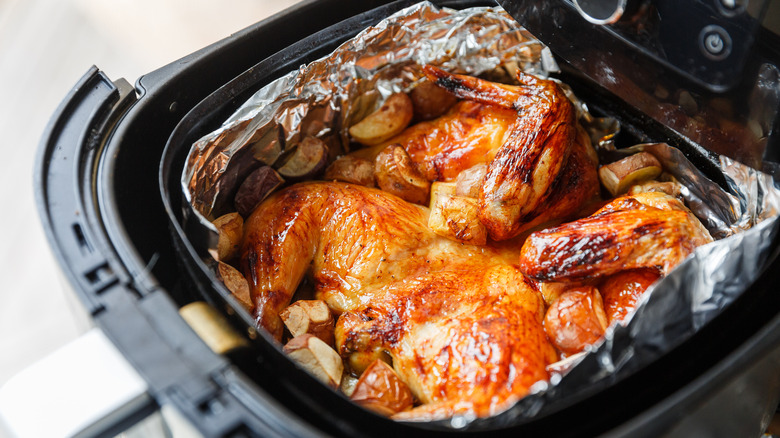Can You Grill Food In An Air Fryer?
As a sizzling-hot kitchen trend in recent years, the compact air fryer appliance increasingly claims valuable countertop space, reaching sales of 25 million units in 2020 and 2021 combined, per NPD. There's a good reason for that. Air fryers can dish out many types of table-ready foods in minutes, typically producing a healthier version of favorite recipes. And, despite the name, frying isn't the only game in town with this sleek, square or egg-shaped, plug-in heat magician; it can perform at least three primary cooking techniques in addition to frying, according to NewAir.
One thing all air-fried foods have in common is the circulated air technique that typically replaces cooking oils, which WebMD credits for the related health benefits. It can reduce calories by 70% to 80% over oil-fried cooking and avoids many negative effects of cooking oils, such as acrylamide chemicals that could lead to cancer.
Air fryers work by pushing hot air of about 400 degrees Fahrenheit, give or take per recipe, around the outer layers of food first, creating that delicious crispy texture we crave. But does that principle apply equally to other cooking methods? Particularly when it comes to grilling, the outer texture and juicy interior are just as important as it is with fried foods. Here's a look at whether you can grill in an air fryer and if it stands up to high BBQ grill-meister expectations.
Smokey flavor and grill marks
Indoor grills get mixed reviews, evidenced by a USA Today look at both open and contact grills, which include griddlers and panini presses. They all have some downsides, and none incorporate hot air as a heating element. That puts an air fryer in an indoor grilling category of its own.
According to Well+Good, a handy countertop air fryer sufficiently replaces an outdoor grill, making it a year-round way to get that kickback summer-night feeling. With a few savvy techniques, you'll have heaping plates of grilled meats and vegetables complete with grill marks and char-broiled flavor. Many air fryers come with grill accessories, per NewAir, including a grill pan or dedicated grill layer. They're also available as attachments from kitchen stores; look for one with grooves for making grill marks and catching flavorful juices.
Sharing tips from health coach and personal chef Jaclyn Huff, Well+Good recommends preheating the air fryer to 400 degrees Fahrenheit for increased charring potential, then reducing the heat slightly before adding food. Cooking times are generally about half those of conventional outdoor grills. Use a thicker cut for meats, slice into equal-size portions, and bring to room temp before placing in the air fryer. If using oils, choose ones that tolerate high heat. Verywell Fit identifies high smoke-point oils such as avocado, canola, corn, and peanut. As for that gotta-have smokey grill flavor? Air Fry Anytime recommends using smoked paprika seasoning or smoke-flavored BBQ sauce. And there's always liquid smoke or smoked salts.
A few precautions
For all the positive aspects of grilling with an air fryer, a few negatives exist as well, primarily involving health concerns. Though lauded for the ability to reduce cancer-causing acrylamide chemicals, air fryers may contribute to the development of undesirable COPs, which are cholesterol oxidation products linked to chronic and heart diseases, notes the Immunity Therapy Center (ITC). The identifying study specifically involved air frying fish at high temps.
To counteract the potential for COP formation when air frying fish, WebMD recommends coating the fish with fresh parsley and chives, which serve as antioxidants for thwarting COPs. Another notable concern over fish-based nutrients, particularly with species such as salmon, is that air frying potentially subdues beneficial omega-3 fatty acids, which increase "good" HDL cholesterol and contribute to heart health.
As with any cooking appliance, proper cleaning of an air fryer reduces the danger of foodborne illnesses, notes Livestrong, and cuts down on grease contamination and burnt flavors in your food. It's also important to use a food thermometer to check internal temperatures, the same as you would when grilling outdoors or baking in a traditional oven.


